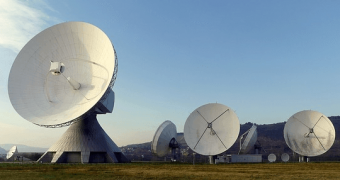
In a series of major developments across the satellite and telecom sectors, global players are pushing the boundaries of connectivity and space technology. Orange Jordan is bringing satellite internet to remote areas, Intelsat is extending satellite life with in-orbit servicing, Amazon has announced it will set a new launch date for its Kuiper satellites after a postponed attempt, and KDDI is rolling out Japan's first direct-to-cell service in partnership with Starlink.
Check out the detailed developments below:
1. Orange Jordan Launches Advanced Satellite Internet to Enhance Connectivity in Remote Areas
Orange Jordan has officially launched what it calls an "advanced satellite Internet service" to strengthen its position in the Jordanian telecommunications market. This move is part of the partnership between Orange Group and Eutelsat Group, aimed at advancing digital inclusion across the Kingdom, according to the company's statement on April 9, 2025.
Orange says this new service, which offers state-of-the-art broadband technology, is designed to provide secure, reliable, and accessible Internet access to remote areas. Designed to meet the needs of both individual consumers (B2C) and businesses (B2B), it ensures high-performance connectivity, meeting the needs of users in diverse locations, including residential buildings and farms and enabling customers to keep up with the latest global trends.
The CEO of Orange Jordan hailed the launch as a significant milestone that underscores the company's role as a responsible digital leader. "Orange Jordan will be the only telecom provider that offers an integrated package of Internet services that also includes, in addition to satellite Internet, fiber, ADSL, 4G, and 5G, solidifying its position as the leading internet provider in Jordan."
The CEO further emphasized that this launch is a crucial step in realizing Jordan's digital transformation goals.
Orange Jordan, a subsidiary of the Orange Global Group, provides an integrated suite of digital solutions—including fixed-line, mobile, Internet, data, and Smart Life Solutions—to approximately 4.1 million customers in Jordan. The company also offers business solutions under its sub-brand, Orange Business.
2. Intelsat Completes Satellite Life-Extension Mission with MEV Technology
Intelsat has successfully completed a satellite life-extension mission—adding five years of service to its Intelsat 901 (IS-901) satellite through in-orbit servicing technology.
In a statement released on Apr 9, 2025, the integrated satellite and terrestrial networks operator announced that "It became the first and only satellite operator to complete a life-extension mission adding five years of service to the Intelsat 901 (IS-901) satellite and its many customers, providing extended reliable and global connectivity."
According to the official release, this milestone marks the first time a satellite operator has extended the operational life of a satellite via a Mission Extension Vehicle (MEV). Developed by Northrop Grumman's Space Logistics LLC, the MEV docked with IS-901 in February 2020—nearly 19 years after the satellite's launch—and remained attached for five years, providing propulsion and attitude control functions after the satellite's fuel was exhausted.
"The MEV mission proved that in-orbit servicing enhances satellite sustainability and efficiency in space," said Jean-Luc Froeliger, Intelsat's Senior Vice President of Space Systems. "We were able to provide five additional years of reliable service to our Network, Media, and Mobility customers, and paved the way for future advancements in satellite servicing."
Following the extended service period, MEV successfully manoeuvred IS-901 to a graveyard orbit for decommissioning, concluding nearly 24 years of operational service.
Geostationary satellites use propellant to remain at a specific orbital location, relocate to a new location or eventually be moved to a graveyard orbit. The MEV has its own propellant and thrusters that operate independently of the satellite. Through in-orbit docking, the MEV allows Intelsat to extend the life of a satellite by several years when the original propellant of that satellite has been depleted, Intelsat explained.
The rendezvous and docking of two spacecraft travelling at speeds of 3 km per second was not only a commercial success but a remarkable technical achievement, Froeliger noted.
Encouraged by the success of MEV-1, Intelsat launched a second mission in 2021 using MEV-2 to extend the life of Intelsat 10-02, a partnership that remains operational. Intelsat says it "continues to seek out and invest in next-generation satellite life-extension projects and other innovation setting the stage for continued advancements and enabling emerging space companies to shape the future of the industry."
Also Read: Satcom: Amazon’s Project Kuiper First Batch Satellite Launch; Eutelsat OneWeb LEO Services, and More
3. Amazon Kuiper Satellite Launch Scrapped Due to Poor Weather
Amazon was forced to postpone the launch of its first Kuiper satellites due to poor weather conditions. A United Launch Alliance (ULA) rocket carrying 27 Kuiper satellites was scheduled to lift off on April 9 from a launchpad in Cape Canaveral, Florida. However, ULA announced it couldn’t proceed with countdown operations as “stubborn cumulus clouds” and heavy winds pushed the launch outside its designated window, according to a livestream.
"Weather is observed and forecast NO GO for liftoff within the remaining launch window at Cape Canaveral this evening," ULA said. The companies said a new launch date will be announced at a later time.
4. KDDI and Okinawa Cellular Launch Direct-to-Cell Satellite Service in Japan with Starlink
Japanese operators KDDI and Okinawa Cellular have launched "au Starlink Direct," which they describe as Japan's first direct-to-cell satellite service, in collaboration with SpaceX's Starlink. The service allows au smartphones to connect directly to satellites, providing mobile connectivity even in remote areas without conventional network coverage.
The service supports 50 smartphone models—including both Android and iPhone devices compatible with satellite communication—and is available free of charge to au users starting April 10, 2025, KDDI announced on Thursday.
By utilizing Starlink satellites equipped with direct communication capabilities, au Starlink Direct allows users to send and receive text messages, share locations, and receive emergency earthquake alerts anywhere under an open sky — including mountainous regions, remote islands, coastal waters, and campgrounds. Android users can also access support from Google’s Gemini AI assistant via text, the company added.
While au's mobile network covers over 99.9 percent of Japan's population, its area coverage is limited to approximately 60 percent due to the country's complex topography. The introduction of au Starlink Direct aims to bridge this gap, ensuring nationwide coverage and enhancing emergency preparedness.
"KDDI is expanding the au coverage area to all of Japan to bring the experience of 'Connecting the Unconnected—wherever you see the sky,'" the official release stated.
Also Read: Globalstar Seeks Regulatory Nod to Launch Satellite Services in India: Report
"I'm very excited to bring direct-to-cell phone connectivity to Japan through KDDI, the first in Asia and one of the first in the world," said Gwynne Shotwell, President and COO of SpaceX. "Both Starlink and direct-to-cell are game-changing technologies, making connecting the unconnected simple and bringing potentially life-saving capability to the people of Japan for disaster and other emergency responses."
A satellite connection icon will appear on users' devices when connected to au Starlink Direct.
KDDI says it will continue to expand its coverage through infrastructure investments, vehicle-mounted base stations, and satellite solutions, reinforcing its vision of "connecting the unconnected" across all 47 prefectures and Japan's territorial waters.















